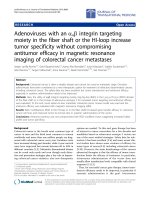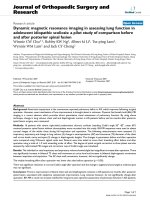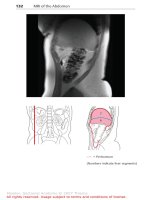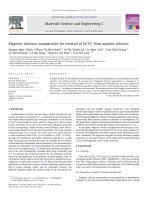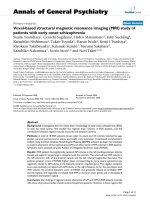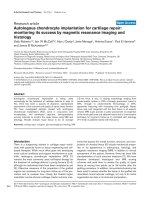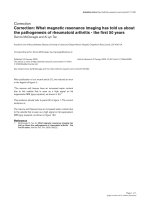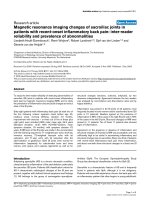Breast magnetic resonance imaging for surveillance of women with a personal history of breast cancer: Outcomes stratified by interval between definitive surgery and surveillance MR imaging
Bạn đang xem bản rút gọn của tài liệu. Xem và tải ngay bản đầy đủ của tài liệu tại đây (454.2 KB, 8 trang )
Park et al. BMC Cancer (2018) 18:91
DOI 10.1186/s12885-018-3998-1
RESEARCH ARTICLE
Open Access
Breast magnetic resonance imaging for
surveillance of women with a personal
history of breast cancer: outcomes stratified
by interval between definitive surgery and
surveillance MR imaging
Vivian Youngjean Park, Eun-Kyung Kim, Min Jung Kim, Hee Jung Moon and Jung Hyun Yoon*
Abstract
Background: Women with a personal history of breast cancer are at increased risk of future breast cancer events, and
may benefit from supplemental screening methods that could enhance early detection of subclinical disease. However,
current literature on breast magnetic resonance (MR) imaging surveillance is limited. We investigated outcomes of
surveillance breast magnetic resonance (MR) imaging in women with a personal history of breast cancer.
Methods: We reviewed 1053 consecutive breast MR examinations that were performed for surveillance in 1044
women (median age, 53 years; range, 20–85 years) previously treated for breast cancer between August 2014 and
February 2016. All patients had previously received supplemental surveillance with ultrasound. Cancer detection rate
(CDR), abnormal interpretation rate and characteristics of MR-detected cancers were assessed, including extramammary
cancers. We also calculated the PPV1, PPV3, sensitivity and specificity for MR-detected intramammary lesions.
Performance statistics were stratified by interval following initial surgery.
Results: The CDR for MR-detected cancers was 6.7 per 1000 examinations (7 of 1053) and was 3.8 per 1000
examinations (4 of 1053) for intramammary cancers. The overall abnormal interpretation rate was 8.0%, and the
abnormal interpretation rate for intramammary lesions was 7.2%. The PPV1, PPV3, sensitivity and specificity for
intramammary lesions was 5.3% (4 of 76), 15.8% (3 of 19), 75.0% (3 of 4) and 98.3% (1031 of 1049), respectively. For MR
examinations performed ≤36 months after surgery, the overall CDR was 1.4 per 1000 examinations. For MR
examinations performed > 36 months after surgery, the overall CDR was 17.4 per 1000 examinations.
Conclusions: Surveillance breast MR imaging may be considered in women with a history of breast cancer,
considering the low abnormal interpretation rate and its high specificity. However, the cancer detection rate was low
and implementation may be more effective after more than 3 years after surgery.
Keywords: Breast cancer, Surveillance, Magnetic resonance imaging
* Correspondence:
Department of Radiology and Research Institute of Radiological Science,
Severance Hospital, Yonsei University College of Medicine, 50-1 Yonsei-ro,
Seodaemun-gu, 03722 Seoul, Republic of Korea
© The Author(s). 2018 Open Access This article is distributed under the terms of the Creative Commons Attribution 4.0
International License ( which permits unrestricted use, distribution, and
reproduction in any medium, provided you give appropriate credit to the original author(s) and the source, provide a link to
the Creative Commons license, and indicate if changes were made. The Creative Commons Public Domain Dedication waiver
( applies to the data made available in this article, unless otherwise stated.
Park et al. BMC Cancer (2018) 18:91
Background
Although women previously treated for breast cancer are
at a statistically significant increased risk of future breast
cancer events [1, 2], annual mammographic screening is
currently the only post-treatment imaging modality recommended for breast cancer follow-up by the American
Society for Clinical Oncology (ASCO) and the National
Comprehensive Cancer Network (NCCN) [3, 4].
There has been limited information on breast magnetic resonance (MR) imaging surveillance in this specific patient population. Previous screening trials using
MR imaging have focused on high-risk women without a
personal history of breast cancer, resulting in increased
invasive breast cancer yields at acceptable recall rates
and positive predictive values (PPV) of biopsy [5–8].
Surveillance breast MR imaging may also have potential
benefits in women previously treated for breast cancer,
primarily by overcoming the decreased sensitivity of
mammography in breasts with dense tissue and
treatment-related changes [9–11]. Despite advances in
locoregional and systemic therapy, recurrence or second
breast cancer rates are approximately 3% to 5% per year
even in early-stage hormone receptor-positive patients
[2, 12]. Therefore, this patient group would benefit from
supplemental screening methods that could enhance early
detection of subclinical disease and ultimately improve
relative survival [13, 14]. Previous studies have reported
that breast MR imaging depicted additional cancers even
after prior or concurrent negative findings of mammography and ultrasound (US) [11, 15, 16]. However, due to
sparse data on surveillance breast MR imaging, the appropriate interval following surgery for initiation of MRI surveillance has not yet been investigated.
At our institution, surveillance breast MR imaging has
recently been implemented as part of the routine posttreatment surveillance protocol for patients previously
treated for breast cancer. These patients had previously
undergone routine supplemental surveillance with US.
As a result, we were able to obtain data from a large
group of patients regarding its performance stratified by
interval between definitive surgery and implementation
of MRI surveillance. The purpose of this study was to investigate the outcomes of surveillance breast MR imaging in women with a personal history of breast cancer.
Page 2 of 8
mastectomy (n = 396). Among them, 222 women were
excluded either because they underwent MR imaging for
reasons other than postoperative surveillance (n = 70);
they had BRCA genetic mutations (n = 20); they had
undergone screening breast MR imaging prior to the
study period (n = 4); or their 12-month imaging followup information was unavailable (n = 128) (Fig. 1). Finally,
1053 breast MR examinations that were performed for
surveillance in 1044 women (median age, 53 years; range,
20–85 years) with a personal history of breast cancer composed our study population. Among them, 9 women
underwent two rounds of screening MR examinations
during the study period. Analysis of Breast Imaging
Reporting and Data System (BI-RADS) category assessments of mammograms and US performed prior to MR
examinations revealed BI-RADS category 1 in 373 examinations (35.4%), category 2 in 434 examinations (41.2%),
and category 3 in 246 examinations (23.4%). The median
follow-up period after surveillance breast MR imaging was
18.7 months (range, 12.0–30.7 months).
Post-treatment surveillance
After definitive breast cancer surgery, patients underwent
follow-up by clinical examination and breast US every
6 months and with mammography, chest radiography, abdominal US and whole body bone scan every 12 months.
After 5 years following initial surgery, patients underwent
annual follow-up by breast US and mammography. Breast
MR imaging was implemented as part of the routine posttreatment surveillance protocol in 2013, and thereafter patients underwent screening breast MR imaging instead of
US at approximately two and five years after surgery. Surveillance breast MR imaging was also performed at the request of clinicians or patients.
The median interval between prior surveillance US
and MR examinations was 6.1 months (range, 0–
13.9 months). In 19 cases (1.8%), surveillance US and
MR imaging were performed on the same day at the
Methods
Study population
This retrospective study was approved by the institutional review board of Yonsei University College of
Medicine and the requirement for informed consent was
waived. Between August 2014 and February 2016, 1285
breast MR examinations were performed in 1266 women
who had been previously treated for breast cancer, either
with breast conserving surgery (BCS) (n = 648) or
Fig. 1 Flowchart of study population selection
Park et al. BMC Cancer (2018) 18:91
request of the referring physician. The median interval
between prior mammography and MR examinations
was 11.5 months (range, 0–65.1 months).
MR imaging technique
Breast MR examinations were performed using two 3 −
Tesla MR scanners (Discover 750, GE Medical Systems,
Milwaukee, WI, USA; Ingenia, Philips Medical Systems,
Best, The Netherlands). Imaging was performed with a
dedicated phased array breast coil (8-channel GE or 16channel Philips) with the patient in the prone position.
Imaging was performed prior to a rapid bolus injection
of contrast agent and six times after injection. Sequences
included a three-plane localizing sequence, axial T2weighted fast-spin-echo and T2-stimulated inversion
recovery (STIR) sequence, and axial T1-weighted nonfat-suppressed or fat-suppressed sequence before contrast administration. The bolus injection consisted of
0.2 mmol/kg body weight of gadolinium-based contrast
agent (Dotarem, Guerbet, Paris, France; Magnevist,
Berlex Laboratories, Wayne, NJ, USA; or Gadovist, Bayer
Scherming Pharma, AG, Berlin, Germancy) and a 20-mL
saline flush delivered at a rate of 2 ml/s. 3D dynamic
post-contrast enhanced (DCE) axial images are then performed in the axial plane and a T1-weighted 3D delayed
postcontrast sequence is acquired in the sagittal plane.
Bilateral examinations were performed for all patients.
MR imaging evaluation
MR images were prospectively interpreted by one of four
radiologists with 6–15 years of experience in breast MR
imaging interpretation. Computer aided evaluation software (CADstream, Confirma, Kirkland, WA) was used
for characterization of lesion kinetics. Of the 1044
women, 89.1% (930 of 1044) previously underwent preoperative MR imaging. Each MR examination was given
a Breast Imaging Reporting and Data System (BI-RADS)
final assessment category based on the breast lesion
morphology and kinetics.
We retrospectively reviewed MR imaging reports,
clinical and imaging records. For lesions assessed as
BI-RADS 3, follow-up breast MRI or US at 6–
12 months was recommended based on the presence
of a US-correlate on previous imaging and the period
of stability. BI-RADS category 3 was also given to
newly found lesions if its findings were probably benign according to the BI-RADS MR lexicon [17]. For
breast or chest wall lesions that were assessed as BIRADS category 4 or 5, targeted US was first performed
and US-guided biopsy or MR-guided biopsy was performed accordingly. For suspicious extramammary
findings found on breast MR imaging, further evaluation with other imaging modalities was performed
with subsequent biopsy when needed.
Page 3 of 8
Statistical analysis
Intramammary cancer was defined as cancer in the ipsilateral breast following BCS or cancer in the contralateral
breast. Extramammary cancer was defined as locoregional
disease (cancer in the ipsilateral axilla, internal mammary
or supraclavicular lymph nodes or in the mastectomy bed)
and distant metastasis.
We calculated the overall cancer detection rate and
abnormal interpretation rates. The overall cancer detection rate for MRI was defined as the total number of
intramammary and extramammary cancers detected at
MR imaging per 1000 examinations. The overall abnormal interpretation rate for MRI was defined as the percentage of MR examinations that were given BI-RADS
categories 0, 3, 4, 5 or those with findings suspicious for
extramammary cancer detected at MR imaging. According to the outcome monitoring section of the BI-RADS
5th edition atlas, we included BI-RADS category 3 in the
numerator of the abnormal interpretation rate because
further imaging is recommended before the next routine
screening [18].
We also calculated outcome measures for MRdetected intramammary lesions. The cancer detection
rate for intramammary lesions was defined as the total
number of intramammary cancers detected at MR imaging per 1000 examinations. The abnormal interpretation rate for intramammary lesions was defined as the
percentage of MR examinations that were given BIRADS categories 0, 3, 4, or 5. Positive MR examinations
were defined as those given BI-RADS categories 4 or 5.
Negative MR examinations were defined as those
assessed as BI-RADS categories 1, 2 or 3. MR examinations with an initial BI-RADS category 0 assessment
were reclassified according to their final assessment.
PPV1 was defined as the percentage of MR examinations
with BI-RADS categories 0, 3, 4, 5 that resulted in a tissue diagnosis of cancer. PPV3 was defined as the percentage of all known breast biopsies performed as a
result of positive MR examinations that resulted in a tissue diagnosis of cancer. A true-positive (TP) result was
defined as a positive MR examination resulting in a diagnosis of cancer within 1 year. A true-negative (TN) result was defined as a negative MR examination and no
detection of cancer within 1 year. A false-negative (FN)
result was defined as a negative MR examination with a
diagnosis of cancer within 1 year. A false-positive (FP)
result was defined as a positive MR examination with no
detection of cancer within 1 year.
In addition, we stratified the above performance statistics according to the interval between initial surgery and
surveillance MR imaging: (1) for MR examinations performed at or less than a 36-month interval and (2) for
examinations performed at more than a 36-month interval following initial surgery. Performance statistics were
Park et al. BMC Cancer (2018) 18:91
Page 4 of 8
compared between the two groups using the Fisher exact
test. We also compared the intervals between prior surveillance US and MR examinations by using the Student t
test. Statistical analyses were performed by using statistical
software (SPSS version 23.0; IBM Corp, Armonk, NY.).
Results
Table 1 shows the clinical-pathologic characteristics of the
1044 women who underwent screening breast MR examinations. The median interval between initial surgery for
Table 1 Characteristics of 1044 women with a personal history
of breast cancer
Characteristic
Cancer detection yield for MRI
Age (years)a
53 (20–85)
Interval between initial surgery
and screening MRIa (months)
27.8 (12.1–167.3)
Preoperative breast MRI
Yes
930 (89.1%)
No
114 (10.9%)
Pathology of initial breast cancer
Ductal carcinoma in situ
185 (17.7%)
Invasive ductal carcinoma
729 (69.8%)
Invasive lobular carcinoma
33 (3.2%)
Tubular carcinoma
25 (2.4%)
Cribiform carcinoma
3 (0.3%)
Mucinous carcinoma
23 (2.2%)
Invasive micropapillary carcinoma
6 (0.6%)
Metaplastic carcinoma
6 (0.6%)
Solid papillary carcinoma
10 (1.0%)
Others
24 (2.3%)
Type of surgery
Partial mastectomy
648 (62.1%)
Mastectomy
396 (37.9%)
Pathological T stage
TX
15 (1.4%)
T0
27 (2.6%)
Tis
188 (18.0%)
T1
624 (59.8%)
T2
176 (16.9%)
T3
12 (1.1%)
T4
2 (0.2%)
Pathological N stage
a
NX
7 (0.7%)
N0
822 (78.7%)
N1
182 (17.4%)
N2
27 (2.6%)
N3
6 (0.6%)
Median value is shown with range in parentheses
breast cancer and first-time screening MR examination
was 27.8 months (range, 12.1–167.3 months). The final assessment categories of the 1053 examinations were as follows: BI-RADS category 1 in 545 examinations (51.8%),
BI-RADS category 2 in 432 examinations (41.0%), BIRADS category 3 in 54 (5.1%), BI-RADS category 4 in 21
examinations (2.0%), BI-RADS category 0 in 1 examination (0.1%). Three examinations assigned as BI-RADS
category 2 and five examinations assigned as BI-RADS
category 1 showed extramammary findings suspicious for
malignancy (0.8%, 8 of 1053).
The overall abnormal interpretation rate for MRI was
8.0% (84 of 1053) and biopsy or further imaging was recommended for 29 examinations (2.7%) with 21 of the 29
exams classified as BI-RADS category 4 and the other 8
exams demonstrating extramammary lesions suspicious
for malignancy (Table 2). Of the 21 BI-RADS category 4
lesions, 18 lesions underwent image-guided biopsy (USguided biopsy [n = 16] or MR-guided biopsy [n = 2]) and
one lesion underwent surgical excision for a US correlate. Among them, 3 lesions were diagnosed as cancer.
All three detected cancers were newly developed contralateral breast cancer, with one cancer detected at a
second-round MR examination. Of the 54 lesions that
were BI-RADS category 3, one cancer was diagnosed
(1.8%). This lesion was an 8-mm enhancing mass at the
contralateral breast and moderate background parenchymal enhancement on preoperative MR imaging performed 5 years ago made accurate comparison difficult.
Because it was considered to have slightly increased in
size, ultrasound correlation was recommended and the
final assessment was upgraded to BI-RADS category 4 at
US. Subsequent US-guided biopsy yielded invasive
ductal carcinoma (Table 3). All of the four MR-detected
intramammary cancers were not detected on prior surveillance US which was performed at a median interval
of 5.5 months (range, 4.6–12.4 months).
Among the 8 examinations with suspicious extramammary findings, five were finally considered negative
based on image-guided biopsy (n = 3) or further imaging
evaluation (PET-CT, whole body bone scan) (n = 2) with
no evidence of malignancy for more than 1 year. Of the
three examinations with extramammary cancer, two were
histologically confirmed by US-guided biopsy (n = 1, chest
wall) or surgical excision (n = 1, mediastinal LN). The
remaining one patient was diagnosed with sternum metastasis based on imaging alone, which was initially detected
on breast MRI and subsequently confirmed by whole body
bone scan and PET-CT (Table 4). Therefore, the overall
cancer detection rate for MRI was 6.7 per 1000 examinations (7 of 1053).
Park et al. BMC Cancer (2018) 18:91
Page 5 of 8
Table 2 Performance of surveillance breast MR imaging
Performance Statistics
Total
(n = 1053)
Cancer detection rate for MRIa
6.7 (7/1053)
c
Initial surgery-MR
interval ≤ 36 months
(n = 709)
Initial surgery-MR
interval > 36 months
(n = 344)
p value
1.4 (1/709)
17.4 (6/344)
0.006
Abnormal interpretation rate for MRI
84/1053 (8.0%)
51/709 (7.2%)
33/344 (9.6%)
0.184
Cancer detection rate for
intramammary lesionsb
3.8 (4/1053)
1.41 (1/709)
8.7 (3/344)
0.105
Abnormal interpretation rate
for intramammary lesions
76/1053 (7.2%)
49/709 (6.9%)
27/344 (7.8%)
0.612
PPV1
4/76 (5.3%)
1/49 (2.0%)
3/27 (11.1%)
0.125
PPV3
3/19 (15.8%)
1/10 (10.0%)
2/9 (22.2%)
0.582
Sensitivity
3/4 (75.0%)
1/1 (100%)
2/3 (66.7%)
> 0.999
Specificity
1031/1049 (98.3%)
698/708 (98.6%)
333/341 (97.6%)
0.199
a
Cancer detection rate for MRI is total number of intramammary and extramammary cancers detected at MR imaging per 1000 examinations
Cancer detection rate for intramammary lesions is total number of total number of intramammary cancers detected at MR imaging per 1000 examinations
Percentage is shown in parentheses
b
c
The mean interval between prior US and MR examinations was slightly greater in MR examinations performed ≤36 months than those performed > 36 months
following initial surgery (6.3 ± 1.0 months vs. 5.9 months
±1.6 months, p < 0.001), but with a mean difference of
0.4 months.
Cancer detection yield for Intramammary lesions
The abnormal interpretation rate for MR-detected intramammary lesions was 7.2% (76 of 1053) and the cancer
detection rate for intramammary lesions was 3.8 per 1000
examinations (4 of 1053). The PPV1 was 5.3% (4 of 76)
and PPV3 was 15.8% (3 of 19). There was only one falsenegative result during the study period, corresponding to
the aforementioned invasive ductal carcinoma assigned as
category 3. The sensitivity of surveillance MR imaging was
75.0% (3 of 4 [95% confidence interval: 71.0%, 79.0%]) and
the specificity was 98.3% (1031 of 1049 [95% confidence
interval: 97.1%, 99.5%]).
Discussion
With recognition of the increased future breast cancer
risk in patients with a personal history of treated breast
cancer and the decreased sensitivity of mammography in
dense breasts, several studies have recently investigated
the performance of surveillance breast MRI examinations [15, 19–23]. Although the patient population and
study design differ somewhat between studies, the reported cancer detection rates range from 10.0 to 18.1 per
1000 examinations [15, 19, 20, 22, 23], which are higher
than the overall cancer detection rate in our study. One
possible explanation is that 37.9% of our study population
underwent mastectomy, whereas the majority of patients
underwent breast conservation surgery in most studies
[11, 15, 22]. Another possible explanation is that the majority (88.1%) of our study population had previously
Cancer detection yield according to interval between
initial surgery and MRI
The overall cancer detection rate for MRI was significantly greater in MR examinations performed with more
than a 36-month interval following initial surgery than
those performed at or less than a 36-month interval
(17.4 per 1000 examinations vs. 1.4 per 1000 examinations, p = 0.006). None of the other performance statistics showed a significant difference between the two
groups (Table 2).
Table 3 Clinical and Imaging Characteristics of the Four Intramammary Breast Cancers Detected on Surveillance Breast MRI
Age range,
years
Initial surgery
intervala
Prior
MRI
Side of
Lesion
MRI
Biopsy Pathology
assessment Method
MRI
finding
Mammographic
density
Mammography
assessment
35–40
60.0
Yes
Contralateral BI-RADS 3
US
IDC
Mass
Heterogeneously
dense
BI-RADS 1
50–55
56.3
Yes
Contralateral BI-RADS 4
US
DCIS
Nonmass Heterogeneously
dense
BI-RADS 2
45–50
24.7
Yes
Contralateral BI-RADS 4
US
Mucinous
carcinoma
Nonmass Heterogeneously
dense
BI-RADS 2
35–40
38.7
Yes
Contralateral BI-RADS 4
MRI
ILC
Nonmass Heterogeneously
dense
BI-RADS 2
IDC invasive ductal carcinoma, DCIS ductal carcinoma in situ, ILC invasive lobular carcinoma
a
Interval between initial surgery and screening breast MR examination by which the subsequent cancer was detected (months)
contralateral
breast
contralateral
breast
contralateral
breast
contralateral
breast
sternum
mediastinum
chest wall
35–40
50–55
45–50
40–45
70–75
60–65
45–50
Suspicious for
malignancy
Suspicious for
malignancy
Suspicious for
malignancy
BI-RADS 4
BI-RADS 4
BI-RADS 4
BI-RADS 3
Final assessment
Initial surgery
intervala
60.4
81.5
38.7
24.7
56.3
Mastectomy 60.4
BCS
BCS
BCS
BCS
BCS
Mastectomy 60.0
Type of
surgery
Metastatic
carcinoma
Metastatic
carcinoma
N/A
ILC
Mucinous
carcinoma
DCIS
IDC
Pathology
ER
PR
pos pos neg
–
–
–
pos neg neg
pos neg neg
–
–
–
–
–
–
T1cN0M0 pos pos neg
T1bN0M0 pos pos neg
TisN0M0
IDC
ILC
IDC
IDC
DCIS with
microinvasion
DCIS
IDC
10
26
23
26
1
15
30
Size,
mm
Initial primary breast cancer
HER2 Pathology
T1bN0M0 pos pos neg
TNM
11
7
15
9
Size,
mm
Subsequent cancer
BCS breast conservation surgery, IDC invasive ductal carcinoma, DCIS ductal carcinoma in situ, ILC invasive lobular carcinoma, N/A not available
a
Interval between initial surgery and surveillance breast MR examination by which the subsequent cancer was detected (months)
Location
Age range,
years
PR
HER2
pos pos neg
neg neg neg
ER
T1bN0M0
T2N0M0
T2N0M0
T2N0M0
pos pos neg
pos neg neg
pos neg neg
pos pos neg
T1miN0M0 pos pos neg
TisN0M0
T2N1M0
TNM
Table 4 Pathological characteristics of MR-detected intramammary breast cancers and extramammary cancers at surveillance breast MR imaging in women with a personal history of breast cancer
Park et al. BMC Cancer (2018) 18:91
Page 6 of 8
Park et al. BMC Cancer (2018) 18:91
undergone preoperative breast MR imaging, whereas only
38.9% and 54.2% of the study population in the study of
Brennan et al. and Lehman et al. had baseline preoperative
MR examinations, respectively [19, 22]. In addition, our
study population had received routine supplemental surveillance US, with a median interval of 6.1 months between prior surveillance US and MR imaging. All of the
four MR-detected intramammary cancers in our study
were not detected by previous surveillance US performed
prior to MR imaging. Therefore, the MR-detected cancers
in our study are more likely to represent truly newly developed cancers after treatment of initial breast cancer,
which may be difficult to detect with surveillance US.
The fact that the cancer detection rate for MR imaging
performed at more than 3 years after surgery (17.4 per
1000) was greater than that for examinations performed
within 3 years (1.41 per 1000) may provide a basis for
establishing guidelines regarding timing of surveillance
MR imaging initiation following definitive breast cancer
surgery. Our overall cancer detection rate was similar to
the incidence cancer detection rate of screening breast
MR imaging in average risk women in a recent study
(7.5 per 1000 examinations, 13 of 1741) [24]. In another
study on women with a history of breast conservation
therapy, of whom 91.8% underwent preoperative MR imaging and all had undergone supplemental surveillance
US, a more than 24-month interval between initial surgery
and MR imaging was an independent factor associated
with MR-detected cancers [15]. Similar results have been
reported for breast MR imaging screening of women with
average risk of breast cancer, with no screening-detected
breast cancer diagnoses made until almost 3 years after a
negative MR study [24]. This has important implications
for the effective implementation of breast MR imaging as
a surveillance modality in the future, as breast MR imaging early in the post-treatment surveillance period may
have relatively low cancer yields − especially with the increased use of preoperative breast MR imaging.
The overall abnormal interpretation rate (8.0%) in our
study was slightly lower than prior studies, which ranged
from 10.7% to 19.3% [15, 20, 22, 25]. Although the PPV1
(5.3%) was slightly lower than that in previous MR imaging studies (approximately 9.4%) [15, 20], it was still
higher than mammographic screening benchmarks from
2004 to 2008 according to the Breast Cancer Surveillance Consortium (4.3%) [26]. In addition, the PPV3 in
our study for intramammary lesions, 15.8% (3 of 19), was
higher than the lower range of reported PPV values of surveillance US in women with a personal history of breast
cancer, which ranged from 9.4% to 52.6% [27–30]. Reported PPV values of surveillance breast MR imaging
in women with a personal history of breast cancer
have been consistently similar to or higher than that
of surveillance US [27–30]. Furthermore, surveillance
Page 7 of 8
MR imaging detected three extramammary rcancers
(0.3%, 3 of 1053), which accounted for 42.8% of MRdetected cancers. Therefore, breast MR imaging may
be more advantageous compared to US as an adjunctive surveillance tool, considering its low abnormal interpretation rate and ability to detect extramammary
malignancy.
Our study had several limitations. First, this was a retrospective study from a single institution. Although our institution recently implemented breast MRI imaging into
our post-treatment surveillance protocol to be performed
two and five years after surgery, MR imaging was also performed at the request of clinicians or patients and therefore, the intervals between surgery and MR imaging were
variable. Second, patients underwent surveillance with
mammography and US prior to MR imaging, which could
have affected the true cancer yield of MRI. Third, the median interval between initial breast cancer surgery and
first-time surveillance MR examination (30.1 months,
range, 12.1–240.2 months) was relatively short.
Conclusions
Our data suggest that surveillance breast MR imaging
may be considered in women with a history of breast cancer, considering the low abnormal interpretation rate and
its high diagnostic performance. However, the cancer detection rate was low and implementation may be more effective after more than 3 years after surgery. Further
research on the appropriate timing for surveillance breast
MR imaging initiation is required, especially in patients
who have undergone preoperative breast MR imaging and
supplemental surveillance US.
Abbreviations
BCS: Breast conserving surgery; BI-RADS: Breast Imaging Reporting and Data
System; CDR: Cancer detection rate; MR: Magnetic resonance; PP: Positive
predictive value; US: Ultrasound
Acknowledgements
None.
Funding
None- for all authors.
Availability of data and materials
Data supporting our findings are presented in the “Results” section.
Researchers interested in source data are invited to write to the
corresponding author.
Authors’ contributions
JHY has made substantial contributions to conception and design, has been
involved in data collection, interpretation of data, and final approval of
version to be published. VYP has made substantial contributions in data
collection, data analysis and wrote and revised the paper. EKK has been
involved in acquisition and interpretation of data, and in revising the
manuscript critically for important intellectual content. MJK has been
involved in acquisition of data and critical review of the manuscript. HJM has
been involved in data acquisition and revising the manuscript critically for
important intellectual content. All authors read and approved the final
manuscript.
Park et al. BMC Cancer (2018) 18:91
Ethics approval and consent to participate
The study protocol was approved by the Severance Hospital Institutional
Review Board (approval number 4–2016-1063). As data were analyzed
anonymously, the requirement for informed consent was waived.
Consent for publication
Not applicable.
Competing interests
The authors declare that they have no competing interests.
Publisher’s Note
Springer Nature remains neutral with regard to jurisdictional claims in
published maps and institutional affiliations.
Received: 12 September 2017 Accepted: 16 January 2018
References
1. Clarke M, Collins R, Darby S, Davies C, Elphinstone P, Evans V, et al. Effects of
radiotherapy and of differences in the extent of surgery for early breast
cancer on local recurrence and 15-year survival: an overview of the
randomised trials. Lancet. 2005;366:2087–106.
2. Darby S, McGale P, Correa C, Taylor C, Arriagada R, Clarke M, et al. Effect of
radiotherapy after breast-conserving surgery on 10-year recurrence and 15year breast cancer death: meta-analysis of individual patient data for 10,801
women in 17 randomised trials. Lancet. 2011;378:1707–16.
3. Khatcheressian JL, Hurley P, Bantug E, Esserman LJ, Grunfeld E, Halberg F, et
al. Breast cancer follow-up and management after primary treatment:
American Society of Clinical Oncology clinical practice guideline update. J
Clin Oncol. 2013;31:961–5.
4. National Comprehensive Cancer Network. Breast Cancer Screening and
Diagnosis (Version 1.2016). />gls/pdf/breast-screening.pdf. Accessed February 14, 2017.
5. Kuhl C, Weigel S, Schrading S, Arand B, Bieling H, Konig R, et al. Prospective
multicenter cohort study to refine management recommendations for
women at elevated familial risk of breast cancer: the EVA trial. J Clin Oncol.
2010;28:1450–7.
6. Kuhl CK, Schrading S, Leutner CC, Morakkabati-Spitz N, Wardelmann E,
Fimmers R, et al. Mammography, breast ultrasound, and magnetic
resonance imaging for surveillance of women at high familial risk for breast
cancer. J Clin Oncol. 2005;23:8469–76.
7. Sardanelli F, Podo F, Santoro F, Manoukian S, Bergonzi S, Trecate G, et al.
Multicenter surveillance of women at high genetic breast cancer risk using
mammography, ultrasonography, and contrast-enhanced magnetic
resonance imaging (the high breast cancer risk italian 1 study): final results.
Investig Radiol. 2011;46:94–105.
8. Warner E, Plewes DB, Hill KA, Causer PA, Zubovits JT, Jong RA, et al.
Surveillance of BRCA1 and BRCA2 mutation carriers with magnetic
resonance imaging, ultrasound, mammography, and clinical breast
examination. JAMA. 2004;292:1317–25.
9. Ashkanani F, Sarkar T, Needham G, Coldwells A, Ah-See AK, Gilbert FJ, et al.
What is achieved by mammographic surveillance after breast conservation
treatment for breast cancer? Am J Surg. 2001;182:207–10.
10. Weinstock C, Bigenwald R, Hochman T, Sun P, Narod SA, Warner E.
Outcomes Of surveillance for contralateral breast cancer in patients less
than age 60 at the time of initial diagnosis. Curr Oncol. 2012;19:e160–4.
11. Cho N, Han W, Han BK, Bae MS, Ko ES, Nam SJ, et al. Breast cancer
screening with mammography plus ultrasonography or magnetic
resonance imaging in women 50 years or younger at diagnosis and treated
with breast conservation therapy. JAMA Oncol. 2017;3:1495–502.
12. Bliss JM, Kilburn LS, Coleman RE, Forbes JF, Coates AS, Jones SE, et al.
Disease-related outcomes with long-term follow-up: an updated analysis of
the intergroup exemestane study. J Clin Oncol. 2012;30:709–17.
13. Houssami N, Ciatto S. Mammographic surveillance in women with a
personal history of breast cancer: how accurate? How effective? Breast.
2010;19:439–45.
14. Lu WL, Jansen L, Post WJ, Bonnema J, Van de Velde JC, De Bock GH. Impact
on survival of early detection of isolated breast recurrences after the
primary treatment for breast cancer: a meta-analysis. Breast Cancer Res
Treat. 2009;114:403–12.
Page 8 of 8
15. Gweon HM, Cho N, Han W, Yi A, Moon HG, Noh DY, et al. Breast MR
imaging screening in women with a history of breast conservation therapy.
Radiology. 2014;272:366–73.
16. Kim EJ, Kang BJ, Kim SH, Youn IK, Baek JE, Lee HS. Diagnostic performance
of and breast tissue changes at early breast MR imaging surveillance in
women after breast conservation therapy. Radiology. 2017;284:656–66.
17. Morris E, Comstock C, Lee C. ACR BI-RADS Magnetic Resonance Imaging. In:
American College of Radiology, editor. ACR BI-RADS Atlas, Breast Imaging
Reporting and Data System. Reston, VA2013.
18. Sickles EA, D'orsi CJ. ACR BI-RADS® follow-up and outcome monitoring. ACR
BI-RADS® atlas breast imaging reporting and data system. Reston, VA:
American college of Radiology. 2013;
19. Brennan S, Liberman L, Dershaw DD, Morris E. Breast MRI screening of
women with a personal history of breast cancer. AJR Am J Roentgenol.
2010;195:510–6.
20. Giess CS, Poole PS, Chikarmane SA, Sippo DA, Birdwell RL. Screening breast
MRI in patients previously treated for breast cancer. Diagnostic Yield for
Cancer and Abnormal Interpretation Rate Acad Radiol. 2015;22:1331–7.
21. Kim MJ, Kim EK, Kwak JY, Park BW, Kim SI, Sohn J, et al. Role of sonography
in the detection of contralateral metachronous breast cancer in an Asian
population. AJR Am J Roentgenol. 2008;190:476–80.
22. Lehman CD, Lee JM, WB DM, Hippe DS, Rendi MH, Kalish G, et al. Screening
MRI in women with a personal history of breast cancer. J Natl Cancer Inst.
2016;108
23. Weinstock C, Campassi C, Goloubeva O, Wooten K, Kesmodel S, Bellevance
E, et al. Breast magnetic resonance imaging (MRI) surveillance in breast
cancer survivors. Spring. 2015;4:459.
24. Kuhl CK, Strobel K, Bieling H, Leutner C, Schild HH, Schrading S.
Supplemental breast MR imaging screening of women with average risk of
breast cancer. Radiology. 2017;283:361–70.
25. Berg WA, Zhang Z, Lehrer D, Jong RA, Pisano ED, Barr RG, et al. Detection of
breast cancer with addition of annual screening ultrasound or a single
screening MRI to mammography in women with elevated breast cancer
risk. JAMA. 2012;307:1394–404.
26. Breast Cancer Surveillance Consortium. National Cancer Institute. http://
www.bcsc-research.org/statistics/benchmarks/screening/2009/table5.html.
Accessed February 16, 2017.
27. Berg WA, Blume JD, Cormack JB, Mendelson EB, Lehrer D, Bohm-Velez M, et
al. Combined screening with ultrasound and mammography vs
mammography alone in women at elevated risk of breast cancer. JAMA.
2008;299:2151–63.
28. Kim HJ, Kwak JY, Choi JW, Bae JH, Shin KM, Lee HJ, et al. Impact of US
surveillance on detection of clinically occult locoregional recurrence after
mastectomy for breast cancer. Ann Surg Oncol. 2010;17:2670–6.
29. Lee JH, Kim EK, Oh JY, Kwon HC, Kim SH, Kim DC, et al. US screening for
detection of nonpalpable locoregional recurrence after mastectomy. Eur J
Radiol. 2013;82:485–9.
30. Suh YJ, Kim MJ, Kim EK, Moon HJ, Kim SI, Park BW. Value of ultrasound for
postoperative surveillance of asian patients with history of breast cancer
surgery: a single-center study. Ann Surg Oncol. 2013;20:3461–8.
Submit your next manuscript to BioMed Central
and we will help you at every step:
• We accept pre-submission inquiries
• Our selector tool helps you to find the most relevant journal
• We provide round the clock customer support
• Convenient online submission
• Thorough peer review
• Inclusion in PubMed and all major indexing services
• Maximum visibility for your research
Submit your manuscript at
www.biomedcentral.com/submit
